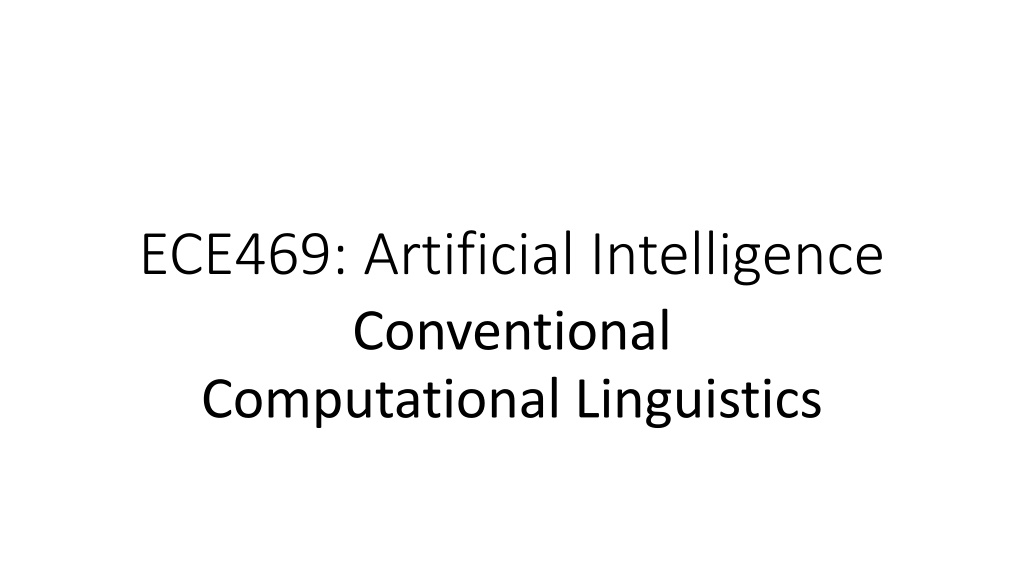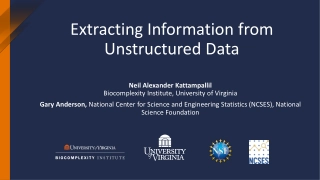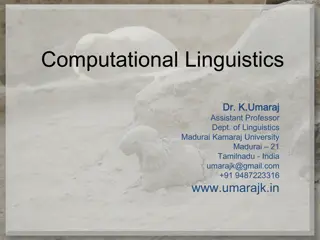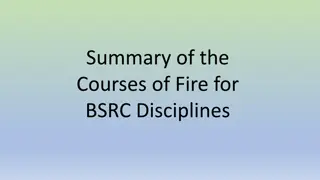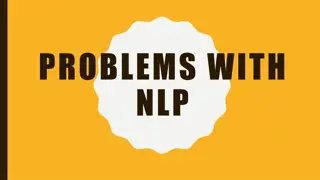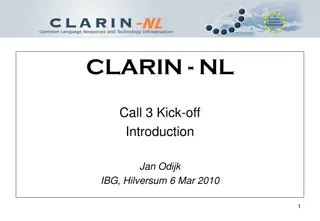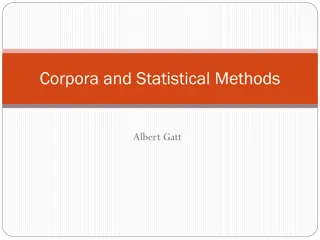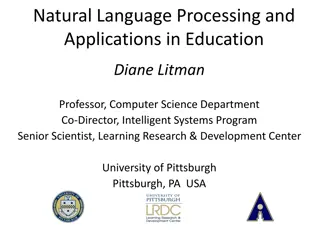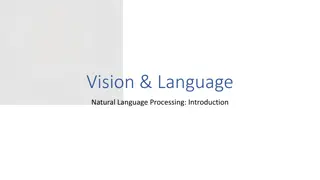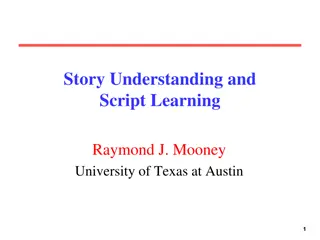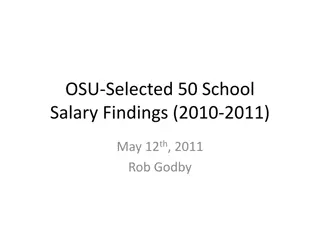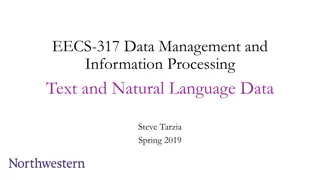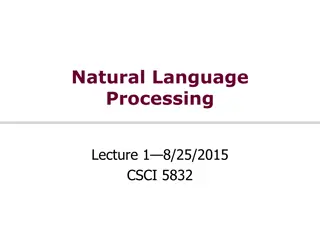Understanding Natural Language Processing: Disciplines and Challenges
Natural Language Processing (NLP) is a subset of AI dealing with processing human languages. This field is intertwined with linguistics, psychology, philosophy, and computational linguistics. Challenges in NLP arise due to the complexities of language understanding, as illustrated by parsing sentences and interpreting meanings.
Uploaded on Nov 19, 2024 | 0 Views
Download Presentation

Please find below an Image/Link to download the presentation.
The content on the website is provided AS IS for your information and personal use only. It may not be sold, licensed, or shared on other websites without obtaining consent from the author. Download presentation by click this link. If you encounter any issues during the download, it is possible that the publisher has removed the file from their server.
E N D
Presentation Transcript
ECE469: Artificial Intelligence Conventional Computational Linguistics
Natural Language Processing (recap) Recall that natural language processing (NLP) is a subfield of artificial intelligence (AI) that deals with the processing of text specified using natural languages Natural languages are languages that are spoken by (or written by or otherwise used by) people; e.g., English, French, Japanese, etc.; this is as opposed to formal languages, such as programming languages In this course, I have divided our unit on NLP is divided into three topics; I am calling them: "Conventional Statistical Natural Language Processing" This will cover statistical NLP approaches that dominated the field until around 2013 "Conventional Computational Linguistics" This covers natural languages, in general, and approaches to processing natural languages that consider linguistics "Deep Learning and NLP" This covers modern approaches to NLP Some sources define computational linguistics to be synonymous with NLP in general; I use the term to refer to the aspects of NLP which related to linguistics, which is the scientific study of natural languages This topic is partially based on Chapter 23 of the 4thedition of the textbook, titled "Natural Language Processing" , starting at Section 23.2 (our previous topic was partially based on Sec. 23.1) Some material comes from Chapter 23 of the 3rdedition, titled "Natural Language for Communication" This topic is also partially based on material from parts of of "Speech and Language Processing" by Jurafsky and Martin, as well as my general knowledge (this was my field as a graduate student)
Disciplines Related to Natural Languages Linguistics: How do words form phrases and sentences? What are the rules, and how can these rules be expressed? What constrains the meaning of a sentence? This field relies on both intuition and mathematical models (e.g., grammars) Psycholinguistics (a subfield of psychology; the study of the mental aspects of language): How do people identify the structure of sentences? How are the meanings of words identified? When does understanding take place? This field relies on experiments with humans and statistical analysis of observations Philosophy: What is meaning and how do words and sentences acquire it? How do words identify objects in the world? This field relies on intuition, hypothetical thought experiments, and mathematical models (e.g., logic) Natural language processing and computational linguistics: How can language be used to accomplish specific tasks? How can the structure of a sentence be identified algorithmically? How can knowledge and meaning be represented? The tools of this field include data structures, algorithms, machine learning, and AI techniques
Why is NLP Hard? (recap) Humans have an uncanny ability to learn a language (at least when they are very young) However, in my opinion, we are very far from having computers that appear to understand (or perhaps actually understand) human languages During our last topic, we explored the question of why NLP is hard by considering the sentence, "I made her duck Now, we will consider a famous example from NLP history: "Time flies like an arrow." According to Steven Pinker in "The Language Instinct", this was the first sentence input to one of the first-ever implemented parsers Supposedly, the implementers were surprised when the parser output five parses All were valid, and they related to five different possible meanings of the sentence
"Time flies like an arrow." (five meanings) Possible meaning #1: Time proceeds as quickly as an arrow proceeds (probably the intended meaning)
"Time flies like an arrow." (five meanings) Possible meaning #1: Time proceeds as quickly as an arrow proceeds (probably the intended meaning) Possible meaning #2: Measure the speed of flies in the same way that you measure the speed of an arrow
"Time flies like an arrow." (five meanings) Possible meaning #1: Time proceeds as quickly as an arrow proceeds (probably the intended meaning) Possible meaning #2: Measure the speed of flies in the same way that you measure the speed of an arrow Possible meaning #3: Measure the speed of flies in the same way that an arrow measures the speed of flies
"Time flies like an arrow." (five meanings) Possible meaning #1: Time proceeds as quickly as an arrow proceeds (probably the intended meaning) Possible meaning #2: Measure the speed of flies in the same way that you measure the speed of an arrow Possible meaning #3: Measure the speed of flies in the same way that an arrow measures the speed of flies Possible meaning #4: Measure the speed of flies that resemble an arrow
"Time flies like an arrow." (five meanings) Possible meaning #1: Time proceeds as quickly as an arrow proceeds (probably the intended meaning) Possible meaning #2: Measure the speed of flies in the same way that you measure the speed of an arrow Possible meaning #3: Measure the speed of flies in the same way that an arrow measures the speed of flies Possible meaning #4: Measure the speed of flies that resemble an arrow Possible meaning #5: Flies of a particular kind, "time flies", are fond of an arrow
"Time flies like an arrow." (five meanings) Possible meaning #1: Time proceeds as quickly as an arrow proceeds (probably the intended meaning) Possible meaning #2: Measure the speed of flies in the same way that you measure the speed of an arrow Possible meaning #3: Measure the speed of flies in the same way that an arrow measures the speed of flies Possible meaning #4: Measure the speed of flies that resemble an arrow Possible meaning #5: Flies of a particular kind, "time flies", are fond of an arrow; if you don t like this one, consider "Fruit flies like an apple."
The Turing Test A common belief espoused by our textbook: What sets humans apart from other animals is that we use language There may be a very strong relation between natural language and intelligence (although I have come to think that the correlation might be overemphasized) Recall that the Turing Test challenges us to create a program that can fool an expert into thinking it is a person by engaging in conversation (we will talk more about this in our final topic) The Loebner prize offers a $100,000 bounty for the first program to pass the Turing test; an annual contest generally awards a much smaller amount to the best entry each year Note that even simple techniques at communicating with a user can perform somewhat impressively, if the user sticks to limited domains and/or does not investigate deeply For example, ELIZA, a program created at MIT by Joseph Weizenbaum in the mid-1960s, used simple pattern-matching techniques to imitate the responses of a Rogerian psychotherapist Some modern, deep-learning-based systems can impressively generate stories or articles after being trained on large corpora of English However, in my opinion, we are far from having any program that can pass the Turing test We will discuss the Turing test more during our final unit of the course (related to the philosophy of AI)
Necessary Knowledge for Communication There are several types of knowledge that humans rely on when engaging in complex conversation Phonetics and phonology knowledge about linguistic sounds (such knowledge is necessary for speech production and speech recognition if the conversation is verbal) Morphology knowledge about the meaningful components of words (we need to recognize tense, when words are plural, etc.) Syntax knowledge about the structural relationships between words, such as how words combine to form phrases and sentences Semantics - knowledge of meaning (this applies to individual words, as well as to sentences) Pragmatics knowledge of meaning account for context and the intentions of the speaker (e.g., is the speaker stating a fact, asking a question, making a request, etc.) Discourse knowledge about linguistic units larger than a single sentence or utterance Real-world knowledge (a.k.a. common-sense knowledge) knowledge about the world that typical people know; we need to constantly rely on, and update, this knowledge For the rest of this topic, we will focus on syntax and (to a lesser degree) semantics
Grammar A grammar (a.k.a. a formal grammar) is a finite set of rules that specifies a language (either a formal language or a natural language) The rules of a grammar define the syntax of the language Formal languages such as C++ or first-order logic have strict mathematical definitions (i.e., defined grammars); natural languages do not A formal language is defined as a (possibly infinite) set of strings Each string is a concatenation of terminal symbols (a.k.a. terminals, tokens, or words) The grammar defines how the terminal symbols are allowed to combine to form longer strings A question naturally arises: Can we model a natural language as a formal language? Linguists strive to figure out grammars for natural languages Note that most modern linguists would say that grammars for natural languages should be descriptive as opposed to prescriptive
Phrase Structure Grammars Until recently, most attempts at modeling grammars of natural languages have been based on the idea of phrase structure The fundamental idea of phrase structure grammars, a.k.a. constituency grammars, is that a group of words may behave as a single unit called a phrase or constituent The phrases can be classified into different syntactic categories (e.g., noun phrase, verb phrase, sentence, etc.) Until recently, such grammars have dominated both linguistics and computational linguistics In recent years, dependency parsing has become a popular alternative (but we will not cover this topic in this course) Before specifying a grammar, you need to choose a grammar formalism, which represents the type or class of formal grammar that can be defined The grammar formalism determines what sorts of syntactic rules can be expressed by the grammar; different formalisms have different expressive power or generative capacity
The Chomsky Hierarchy The Chomsky hierarchy defines four types of formal grammars that are useful for various tasks; namely: Unrestricted grammars (type 0) Context-sensitive grammars (type 1) Context-free grammars (type 2) Regular grammars (type 3) These are numbered from the most powerful / least restrictive (type 0) to the least powerful / most restrictive (type 3) It is often useful (i.e., simpler and more efficient) to use the most restrictive type of grammar that suits your purpose For example, regular grammars are generally powerful enough to specify rules for tokenization, and they are often used for this purpose It has been well established that the syntax of natural languages cannot be defined by regular grammars It has long been debated whether context-free grammars (CFGs) are capable of defining natural languages It has been shown that a few constructs in some languages (but not English) are not context free However, CFGs have been the most common formalism used by linguists to represent grammar CFGs are also popular for expressing the syntax rules of computer programming languages
Context-free Grammars When a CFG is used to represent a natural language, the names of syntactic categories (phrases) and parts of speech are nonterminal symbols (or nonterminals) As mentioned earlier, a language (formal or natural) is a concatenation of terminal symbols For natural languages, the terminal symbols typically represent words, but in some cases, they can represent parts of words, punctuation, etc. CFGs define nonterminals using rewrite rules (a.k.a. productions) Example: S NP VP; the arrow can be read as, "can have the form of" CFGs require that every rule has a single nonterminal symbol on the left-hand side The right-hand is unconstrained (that is, it may consist of a sequence of zero or more nonterminal symbols and terminal symbols) As previously mentioned, linguists have attempted to use CFGs to express the rules for natural languages, although it is believed that some natural languages include constructions that are not context-free CFGs are also popular for expressing the syntax rules of computer programming languages Every CFG also defines one nonterminal to be the start symbol; for natural languages, this is typically S, representing a sentence
The Wumpus World The wumpus world is a game that can easily be implemented as a computer program This game was introduced much earlier in the textbook, when discussing types of logic Some rules that define the wumpus world are: You are moving around a rectangular grid of rooms One room contains the wumpus (a giant beast that moves around and wants to kill you), and one room contains a pot of gold Your goal is to find the gold without getting killed by the wumpus You can move one square at a time; up, down, left, or right Some rooms contain bottomless pits that trap anyone who enters (except the wumpus) If you are one room away from a bottomless pit, you will feel a breeze If you step into the square with the wumpus, and the wumpus is alive, you die a miserable death If you are one square away from the wumpus, you will smell it You have a single arrow that can be shot in one direction; it will travel to the end of the grid; this can be used to kill the wumpus
Lexicons A grammar needs to include all the allowable terminal symbols For a natural language, this often takes the form of a lexicon, which is a list of the allowable words in the language Often a lexicon will also list the syntactic category of each word Such categories include nouns, pronouns, names, verbs, adjectives, adverbs, articles, prepositions, conjunctions, etc. We have seen in our previous topic that these categories are often called parts of speech (POS) Although the lexicon is often specified separately from the rest of the grammar, it can easily be specified as part of a CFG We will see an example of a lexicon shortly
Probabilistic Context Free Grammars The formalism we will use to express grammars including lexicons is actually an extension of a CFG called a probabilistic context-free grammar (PCFG) Every rule will include an associated number, indicating the frequency of the right-hand side given the left- hand side Recall that the left-hand side will always be a single nonterminal representing a type of phrase or a part of speech It is typical to consider these frequencies to be probabilities, representing the likelihood that a phrase or POS is formed a certain way The probabilities of all the valid right-hand sides for any nonterminal will sum to 1 Example: S NP VP [0.90] As with a regular CFG, this rule tells us that a sentence can have the form of a noun phrase followed by a verb phrase In a PCFG, the rule additionally tells us that 90% of sentences have this form The next two slides show examples of a lexicon and grammar that might be appropriate to allow sentences related to the wumpus world The vertical bars in these examples can be read as "or"; this provides a shorthand for representing multiple rules in one line
Notes About the Example Grammar Note that we don't need to separate the lexicon and grammar The lexicon is represented as a CFG, and it can be included as part of the main grammar The types of phrases recognized by the grammar are sentence (S), noun phrase (NP), verb phrase (VP), list of adjectives (Adjs), prepositional phrase (PP), and relative clause (RelClause) When we include the lexicon, the parts of speech, as well as types of phrases, are represented by non-terminal symbols The start symbol for this grammar is S That s not explicitly stated here, but it is often assumed for a natural language grammar It is also common to make the start symbol the left-hand side of the first rule As previously mentioned, the vertical bars in the rules can be read as "or"; this is not formally part of the CFG formalism, but it provides a shorthand for indicating multiple rules on one line For example, what looks like a single rule S NP VP | S Conj S really represents two separate rules S NP VP and S S Conj S This grammar both over-generates (e.g., it allows "I smells pits wumpus Boston") and under- generates (e.g., it does not allow "I think the wumpus is smelly")
Parse trees A parse tree shows how a string can form a sentence according to a context-free grammar Terminals (i.e., words) are represented by leaves and nonterminals (phrases) are represented by internal nodes Generally, parse trees are specified for sentences, in which case the root of the tree is labeled with S If such a parse tree exists, then the input string is accepted by the grammar To the right, we see an example of a parse tree for the sentence "Every wumpus smells If our PCFG were used to randomly generate a parse tree, the probability that this specific parse tree would result is: 0.9 * 0.25 * 0.05 * .015 * 0.4 * 0.10 = 0.0000675 In this case, this is also the probability that the specific sentence would result That is because this is the only valid parse tree for the sentence (i.e., the sentence is syntactically unambiguous) We can also indicate this parse tree with text as follows: [S [NP [Article every] [Noun wumpus]][VP [Verb smells]]]
Parsing Our textbook defines parsing as "the process of analyzing a string of words to uncover its phrase structure, according to the rules of a grammar" Parsing can be viewed as the process of searching for a valid parse tree that represents a sentence Top-down parsing starts with the S symbol and searches for a tree with the words as its leaves Bottom-up parsing starts with the words and searches for a tree with root S Both types of searches can be inefficient; repeating calculations involving substrings can lead to exponential explosion Top-down parsers can generate nodes that cannot be latched to words, and bottom-up parsers can generate partial parses of the words that cannot appear in any sentence Top-down parsing can also run into infinite loops with left-recursive rules (e.g., VP VP NP) Consider these two sentences that have the first 10 words in common: "Have the students in section 2 of Computer Science 101 take the exam." "Have the students in section 2 of Computer Science 101 taken the exam?" If a left-to-right algorithm guesses wrong for the first word, it will have to backtrack This type of backtracking is inevitable to some degree, but we do not want to have to reanalyze every intermediate phrase that has already been parsed
Chart Parsing Chart parsers store the results for substrings in a data structure known as a chart This is example of dynamic programming For example, in the previous case, once it is known that "the students in section 2 of Computer Science 101" is a valid NP, this will not need to be reanalyzed The book describes one chart parsing algorithm known as the CYK algorithm, a.k.a. the CKY algorithm (named after its inventors, Cocke, Younger, and Kasami) We are not going to cover the details of the algorithm in this course The CYK algorithm has space complexity O(n2m) and time complexity O(n3m), where n is the number of words in the sentence and m is the number of nonterminal symbols in the grammar Technically speaking, a chart parser is really a recognizer and not a parser You can expand the algorithm to determine all the valid parses, but to do so, you cannot avoid exponential time in the worst case This is because some ambiguous sentences can have exponentially many valid parse trees
Treebanks The grammar rules of a CFG and the probabilities (and rules) of a PCFG can be learned if an appropriate manually tagged corpus is available As mentioned in our previous topic, a treebank is a corpus in which words have been labeled with their POS, and sentences have been manually parsed The Penn Treebank is probably the best-known treebank Documents from various sources, containing over 3 million words in total, have been manually annotated with parts of speech (for words) and parse trees (for sentences) Without a treebank, learning the grammar rules and their probabilities is very difficult It is still possible to some extent using a variation of the expectation maximization algorithm, assuming that the parts of speech and types of phrases are known We won t discuss the details, but there are several drawbacks: it is slow; there are generally many low- probability, unusual rules; and ultimately, the results are usually not very good Then again, an annotated treebank will also generally lead to some unusual rules E.g., one rule based on the Penn treebank is: VP VBP PP PP PP PP PP ADVP PP The sentence that led to this rule is: "This mostly happens because we go from football in the fall to lifting in the winter to football again in the spring."
Lexicalized PCFGs There is a lot that the grammar so far is not handling For example, one general sort of problem is that it is not true that one NP is equal to any other regardless of context In reality, it is much more common, for example, to "eat a banana" than it is to "eat a bandanna", but these are recognized as equally likely by our PCFG The head of a phrase is the most important word in the phrase (linguistically speaking) For example, the head of a verb phrase is the main verb, and the head of a noun phrase is the main noun (but heads are not always this obvious) One way to handle this problem is to use a lexicalized PCFG, a form of augmented grammar in which every left-hand-side nonterminal has a parameter representing a terminal symbol Then, the probabilities for a rule can depend on the relationships between head words of phrases One obvious problem with this approach is the need to have probability estimates for all possible pairs of verbs and nouns for a rule like this In practice, this is not possible based on a treebank, so you often need to use some sort of smoothing technique when no evidence is available The next slide shows an example of an excerpt from a lexicalized PCFG
Lexicalized PCFG Example (from book) VP(v) Verb(v) NP(n) VP(v) Verb(v) NP(n) Article(a) Adjs(j) Noun(n) NP(n) NP(n) Conjunction(c) NP(m) Verb(ate) ate Noun(banana) banana [P1(v,n)] [P2(v)] [P3(n,a)] [P4(n,c,m)] [0.002] [0.0007]
Case Agreement One specific problem with the grammar so far is that it does not handle case agreement For example, certain pronouns (e.g., "I", "we", etc.) can only be subjects Others (e.g., "me", "us", etc.) can only be objects The partial grammar to the right shows how this can be handled with a non-augmented grammar However, there are various other types of agreement that also need to be handled E.g., subject-verb agreement states that the subject and verb must agree in number To handle all such cases with normal productions would cause exponential growth of the grammar
More General Augmented Grammars An alternative is to rely on a more general augmented grammar We can augment nonterminal symbols with additional parameters, or variables, optionally in addition to the lexical argument Example: NP (case) Pronoun (case) This means that a noun phrase can have the form of a pronoun, and the case of the NP is the same as the case of the Pronoun The example on the next slide shows how augmentations can be used to handle case agreement and subject-verb agreement, as well as head words The probabilities are not shown for this example (so this is a snippet of an augmented CFG, not an augmented PCFG) We could add probabilities to make it an augmented PCFG
Semantic Interpretation Moving on to semantics, augmented grammars can also be used to generate semantic interpretations of expressions This roughly refers to the extraction of the meaning of grammatical expressions To start off with an example simpler than a natural language, we will look at a grammar for arithmetic expressions augmented with semantics (on the next slide) We will then look at a sample parse tree for an expression according to the grammar (the following slide) When it comes to semantic interpretation of natural language text, our textbook and much of the NLP community interpret this as associating a first-order logic (FOL) expression with a phrase Although we have not covered FOL formally, recall that we had a brief introduction to it early in our topic on probability (discussing its shortcomings to deal with the dental domain) An English example: "Ali loves Bo" can be represented as the FOL expression Loves(Ali, Bo) We will look at a small grammar that can generate four English sentences along with a sample parse tree for one of those sentences (three slides forward) The particular notation being used for that grammar is called -notation, which was introduced in the textbook's chapter on FOL; we will not discuss the details
Its Complicated There are many additional complications related to semantic interpretation; we will just consider a few Representing precise times or complex temporal relationship is very difficult using FOL; even dealing with tense is unwieldy; for example, using what are sometimes referred to as event variables: "Ali loves Bo" could be represented as: E1 Loves(Ali, Bo) ^ During(Now, Extent(E1)) "Ali loved Bo" could be represented as: E2 Loves(Ali, Bo) ^ After(Now, Extent(E2)) Now consider an example of quantification, such as "Every agent feels a breeze"; there are two reasonable interpretations: 1. a a Agents b b Breezes ^ Feel(a,b) 2. b b Breezes ^ a a Agents Feel(a,b) I personally consider either interpretation to be reasonable there, but sometimes, one seems to be the clearly intended meaning; consider my two examples: "Every student has a user ID" "Every machine learning system agrees on a classification" When we discussed probability, we saw that FOL does not provide a reasonable way to deal with uncertainty A more philosophical issue is that to understand an FOL expression, we need to understand the meanings of the individual terms (such as Loves, After, Ali, Breezes, etc.) Overall, I do not personally consider FOL an adequate formalism for representing natural language semantics
Pragmatics, Discourse, Real-World Knowledge We still need to complete the interpretation by adding context-dependent information concerning the current situation; this is part of pragmatic interpretation One obvious need for pragmatic info is to resolve meaning of indexicals, which are phrases that refer directly to the current situation Example: "I am in Boston today"; the meaning of "I" and "today" depends on who is speaking and when Discourse processing refers to semantic interpretation involving multiple sentences or utterances Resolving pronouns is an example of reference resolution, and this often spans sentences; consider my two examples: "The customer called the waiter. He asked for his check." "The customer called the waiter. He came to take their order." Real-world knowledge is also extremely important (I think this was demonstrated in the previous example, and will be again in our next examples)
Ambiguity The book gives examples of ambiguity "taken from newspaper headlines" (it is unclear to me if they are real); here are just a few: "Squad helps dog bite victim" "Helicopter powered by human flies" "Portable toilet bombed; police have nothing to go on" Again, I claim that these demonstrate the importance of real-world knowledge for semantic understanding We understand the intended meanings because the alternatives are preposterous, not due to syntactic clues Ambiguity in natural language is extremely common! Book (3rdEdition): " almost every utterance is highly ambiguous, even though the alternative interpretations might not be apparent to a native speaker" Book (4thEdition): " almost every sentence is ambiguous, with multiple parses (even hundreds), even when the single preferred parse is the only one that native speakers notice"
Types of Ambiguity A funny example from the 4thEdition of the textbook is related to a Groucho Marx joke First, they provide the sentence "Outside of a dog, a book is a person's best friend." Then, they follow it up with "Inside of a dog it's too dark to read." This example involves lexical ambiguity; some words (such as "outside") have more than one meaning Syntactic ambiguity (a.k.a. structural ambiguity) can occur without lexical ambiguity For example: "I smelled a wumpus in 2, 2"; it is unclear if the PP modifies "smelled" or "a wumpus"; this also leads to semantic ambiguity Semantic ambiguity can occur without lexical ambiguity or syntactic ambiguity An example from the 2ndedition of the textbook is the title "Attack of the Cat People"; in other instances, "cat people" are people who love cats Sometimes, there is ambiguity between literal and figurative interpretations of a sentence (and it is a pet peeve of mine that "literally" is often used figuratively!) Figures of speech are surprisingly common in everyday speech; one case is metonymy in which one object stands for another; e.g., "Chrysler announced a new model" Other relevant complications of natural language include metaphors, similes, analogies, etc.
Disambiguation Disambiguation refers to the determination of the intended meaning of an utterance or sentence To disambiguate natural language, you need to consider four models of knowledge: The world model indicates the likelihood that a proposition occurs in the world The mental model indicates the likelihood that the speaker would form the intent to express the fact given that it occurs The language model indicates the likelihood that a certain string would be chosen to express the content, given that the speaker already has the intention to express it The acoustic model indicates, for spoken communication, the likelihood that the sequence of sounds would be generated given that a string was chosen Final funny example: A politician says, "I am not a crook."; a crook can also be a hooked shepherd's staff I would argue that it is solely due to the mental model that we understand the (likely) intended meaning of this sentence
